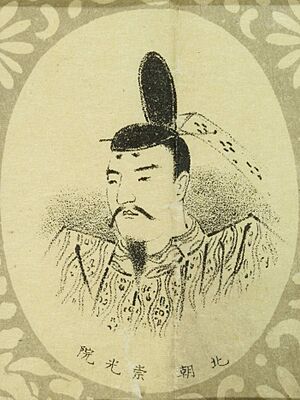Emperor Sukō facts for kids
Quick facts for kids Emperor Sukō崇光天皇 |
|||||
|---|---|---|---|---|---|
 |
|||||
| 3rd Northern Emperor | |||||
| Reign | November 18, 1348 – November 26, 1351 | ||||
| Coronation | February 3, 1350 | ||||
| Predecessor | Kōmyō | ||||
| Successor | Go-Kōgon | ||||
| Born | May 25, 1334 | ||||
| Died | January 31, 1398 (aged 63) | ||||
| Burial | Daikōmyō-ji no Misasagi (大光明寺陵) | ||||
| Issue | See list | ||||
|
|||||
| Father | Emperor Kōgon | ||||
| Mother | Sanjō Shūshi | ||||
Emperor Sukō (崇光天皇, Sukō Tennō) (born May 25, 1334 – died January 31, 1398) was an important figure in Japanese history. He was the third Emperor of the Northern Court. This was during a time in Japan called the Period of the Northern and Southern Courts. During this period, there were two separate Imperial Courts, each with its own emperor. Emperor Sukō ruled from 1348 to 1351.
Contents
Family and Early Life
Emperor Sukō's personal name was first Masuhito. Later, it was changed to Okihito.
His father was Emperor Kōgon, who was also a Northern Court Emperor. Emperor Kōmyō, who ruled before Sukō, was his uncle. This means Emperor Kōmyō was Emperor Kōgon's younger brother.
Emperor Sukō had several children:
- His first son was Imperial Prince Fushimi-no-miya Yoshihito (1351–1416). He started the Fushimi-no-miya family line. This family was a special branch of the Imperial Family. They were important in deciding who would become emperor until 1947.
- His second son was Imperial Prince Priest Koshin (1358–1391).
- His first daughter was Princess Suiho.
- His third son was Imperial Prince Priest Kojo.
Events During Sukō's Reign
Emperor Sukō sat on the Chrysanthemum Throne (the symbol of the Japanese emperor) from November 18, 1348, to November 22, 1351.
Becoming Emperor
In 1348, Sukō became the Crown Prince. This meant he was next in line to be emperor. In the same year, he became the Northern Emperor. This happened after Emperor Kōmyō decided to step down.
Challenges and Changes
Even though Emperor Kōgon was still a powerful figure behind the scenes, there was a big rivalry. This was between two powerful leaders, Ashikaga Takauji and Ashikaga Tadayoshi.
In 1351, Takauji decided to switch his support to the Southern Court. This forced Emperor Sukō to give up his throne. The idea was to bring the two Imperial lines back together.
However, this peace did not last long. In April 1352, the Southern Dynasty left Kyoto. They took with them the retired Northern Emperors, Emperor Kōgon and Emperor Kōmyō. They also took Emperor Sukō and the Crown Prince Tadahito. Because of this, Takauji chose Emperor Kōgon's second son, Imperial Prince Iyahito, to become the new emperor.
Later Life and Legacy
Emperor Sukō returned to Kyoto in 1357. His son, Imperial Prince Yoshihito, then tried to work with the Bakufu (the military government). He hoped to be named Crown Prince. But the Bakufu decided to make Emperor Go-Kōgon's son the Crown Prince instead. This son later became Emperor Go-En'yū.
Emperor Sukō passed away in 1398. But his wish for his family to rule came true much later. About 30 years after his death, in 1428, his great-grandson Hikohito became emperor. This happened because Hikohito was adopted by Emperor Shōkō. Hikohito then became Emperor Go-Hanazono.
Emperor Sukō is buried at a place called Daikōmyōji no misasagi in Fushimi-ku, Kyoto.
Time Periods During His Reign
During Emperor Sukō's reign, Japan was in the Nanboku-chō period. This means there were two different ways of counting the years, depending on which court you followed.
Southern Court Eras
The eras recognized by the official (legitimate) court were:
Northern Court Eras
The eras recognized by the Northern Court were:
Rival Emperor
During Emperor Sukō's time, the emperor of the Southern Court was Emperor Go-Murakami.
See also
 In Spanish: Sukō Tennō para niños
In Spanish: Sukō Tennō para niños
- Emperor of Japan
- List of Emperors of Japan
- Imperial cult

